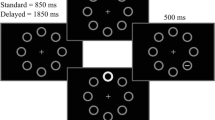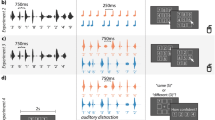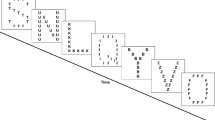Abstract
Maintaining a selective attention set allows us to efficiently perform sensory tasks despite the multitude of concurrent sensory stimuli. Unpredictably occurring, rare events nonetheless capture our attention, that is, we get distracted. The present study investigated the efficiency of control over distraction as a function of preparation time available before a forthcoming distracter. A random sequence of short and long tones (100 or 200 ms with 50–50 % probability) was presented. Independently from tone duration, occasionally (13.3 % of the time), the pitch of a tone was changed. Such rare pitch variants (distracters) usually lead to delayed and less precise discrimination responses, and trigger a characteristic series of event-related potentials (ERPs) reflecting the stages of distraction-related processing: starting with negative ERPs signaling the sensory registration of the distracter; a P3a—usually interpreted as a reflection of involuntary attention change and finally the so-called reorienting negativity signaling the restoration of the task-optimal attention set. In separate conditions, 663 or 346 ms before each tone (long or short cue-tone interval), a visual cue was presented, which signaled whether the forthcoming tone was a distracter (rare pitch variant), with 80 % validity. As reflected by reduced reaction time delays and P3a amplitudes, valid cues led to the prevention of distraction, but only in the long cue-tone interval condition. The analyses of the cue-related P3b and contingent negative variation showed that participants made more effort to utilize cue information to prevent distraction in the long cue-tone than in the short cue-tone interval condition.





Similar content being viewed by others
References
Bakeman R (2005) Recommended effect size statistics for repeated measures designs. Behav Res Methods 37:379–384. doi:10.3758/BF03192707
Berti S, Schröger E (2001) A comparison of auditory and visual distraction effects: behavioral and event-related indices. Cogn Brain Res 10:265–273. doi:10.1016/S0926-6410(00)00044-6
Escera C, Corral M-J (2003) The distraction potential (DP), an electrophysiological tracer of involuntary attention control and its dysfunction. In: Herrmann M, Reinvang I, Greenlee MW (eds) The Cognitive Neuroscience of Individual Differences-New Perspectives. Bibliotheks-und Informations system. der Universität Oldenburg, Oldenburg, pp 63–76
Escera C, Corral MJ (2007) Role of mismatch negativity and novelty-P3 in involuntary auditory attention. J Psychophysiol 21:251–264. doi:10.1027/0269-8803.21.34.251
Escera C, Alho K, Winkler I, Näätänen R (1998) Neural mechanisms of involuntary attention to acoustic novelty and change. J Cogn Neurosci 10:590–604. doi:10.1162/089892998562997
Escera C, Yago E, Alho K (2001) Electrical responses reveal the temporal dynamics of brain events during involuntary attention switching. Eur J Neurosci 14:877–883. doi:10.1046/j.0953-816x.2001.01707.x
Friedman D, Cycowicz YM, Gaeta H (2001) The novelty P3: an event-related brain potential (ERP) sign of the brain’s evaluation of novelty. Neurosci Biobehav Rev 25:355–373. doi:10.1016/S0149-7634(01)00019-7
Gaillard AWK (1976) Effects of warning-signal modality on the contingent negative variation (CNV). Biol Psychol 4:139–153. doi:10.1016/0301-0511(76)90013-2
Horváth J, Bendixen A (2012) Preventing distraction by probabilistic cueing. Int J Psychophysiol 83:342–347. doi:10.1016/j.ijpsycho.2011.11.019
Horváth J, Winkler I, Bendixen A (2008) Do N1/MMN, P3a, and RON form a strongly coupled chain reflecting the three stages of auditory distraction? Biol Psychol 79:139–147. doi:10.1016/j.biopsycho.2008.04.001
Horváth J, Sussman E, Winkler I, Schröger E (2011) Preventing distraction: assessing stimulus-specific and general effects of the predictive cueing of deviant auditory events. Biol Psychol 87:35–48. doi:10.1016/j.biopsycho.2011.01.011
Johnson R, Donchin E (1978) On how P300 amplitude varies with the utility of the eliciting stimuli. Electroencephalogr Clin Neurophysiol 44:424–437. doi:10.1016/0013-4694(78)90027-5
Li B, Parmentier FBR, Zhang M (2013) Behavioral distraction by auditory deviance is mediated by the sound’s informational value. Exp Psychol (formerly Zeitschrift für Experimentelle Psychologie) 60:260–268. doi:10.1027/1618-3169/a000196
Ljungberg JK, Parmentier FBR, Leiva A, Vega N (2012) The informational constraints of behavioral distraction by unexpected sounds: the role of event information. J Exp Psychol Learn Mem Cogn 38:1461–1468. doi:10.1037/a0028149
Macmillan NA, Creelman CD (2005) Detection theory: a user’s guide, 2nd edn. Lawrence Erlbaum Associates, Mahwah
Näätänen R, Picton T (1987) The N1 wave of the human electric and magnetic response to sound: a review and an analysis of the component structure. Psychophysiology 24:375–425. doi:10.1111/j.1469-8986.1987.tb00311.x
Näätänen R, Gaillard AW, Mäntysalo S (1978) Early selective-attention effect on evoked potential reinterpreted. Acta Psychol 42:313–329. doi:10.1016/0001-6918(78)90006-9
Näätänen R, Simpson M, Loveless NE (1982) Stimulus deviance and evoked potentials. Biol Psychol 14:53–98. doi:10.1016/0301-0511(82)90017-5
Nuwer MR, Comi G, Emerson R et al (1998) IFCN standards for digital recording of clinical EEG. Electroencephalogr Clin Neurophysiol 106:259–261. doi:10.1016/S0013-4694(97)00106-5
Olejnik S, Algina J (2003) Generalized eta and omega squared statistics: measures of effect size for some common research designs. Psychol Methods 8:434–447. doi:10.1037/1082-989X.8.4.434
Parmentier FBR, Hebrero M (in press) Cognitive control of involuntary distraction by deviant sounds. J Exp Psychol: learning, memory, and cognition. doi:10.1037/a0032421
Parmentier FBR, Elsley JV, Ljungberg JK (2010) Behavioral distraction by auditory novelty is not only about novelty: the role of the distracter’s informational value. Cognition 115:504–511. doi:10.1016/j.cognition.2010.03.002
Parmentier FBR, Elsley JV, Andrés P, Barceló F (2011) Why are auditory novels distracting? Contrasting the roles of novelty, violation of expectation and stimulus change. Cognition 119:374–380. doi:10.1016/j.cognition.2011.02.001
Ritter W, Paavilainen P, Lavikainen J et al (1992) Event-related potentials to repetition and change of auditory stimuli. Electroencephalogr Clin Neurophysiol 83:306–321. doi:10.1016/0013-4694(92)90090-5
Roeber U, Berti S, Schröger E (2003) Auditory distraction with different presentation rates: an event-related potential and behavioral study. Clin Neurophysiol 114:341–349. doi:10.1016/S1388-2457(02)00377-2
SanMiguel I, Linden D, Escera C (2010a) Attention capture by novel sounds: distraction versus facilitation. Eur J Cogn Psychol 22:481–515. doi:10.1080/09541440902930994
SanMiguel I, Morgan HM, Klein C et al (2010b) On the functional significance of Novelty-P3: facilitation by unexpected novel sounds. Biol Psychol 83:143–152. doi:10.1016/j.biopsycho.2009.11.012
Schröger E, Wolff C (1998a) Attentional orienting and reorienting is indicated by human event-related brain potentials. NeuroReport 9:3355–3358
Schröger E, Wolff C (1998b) Behavioral and electrophysiological effects of task-irrelevant sound change: a new distraction paradigm. Cogn Brain Res 7:71–87. doi:10.1016/S0926-6410(98)00013-5
Schröger E, Giard M-H, Wolff C (2000) Auditory distraction: event-related potential and behavioral indices. Clin Neurophysiol 111:1450–1460
Sussman E, Winkler I, Schröger E (2003) Top-down control over involuntary attention switching in the auditory modality. Psychon Bull Rev 10:630–637. doi:10.3758/BF03196525
Tecce JJ (1972) Contingent negative variation (CNV) and psychological processes in man. Psychol Bull 77:73–108. doi:10.1037/h0032177
Walter WG, Cooper R, Crow HJ et al (1967) Contingent negative variation and evoked responses recorded by radio-telemetry in free-ranging subjects. Electroencephalogr Clin Neurophysiol 23:197–206. doi:10.1016/0013-4694(67)90116-2
Wetzel N, Schröger E (2007) Cognitive control of involuntary attention and distraction in children and adolescents. Brain Res 1155:134–146. doi:10.1016/j.brainres.2007.04.022
Wetzel N, Widmann A, Schröger E (2009) The cognitive control of distraction by novelty in children aged 7-8 and adults. Psychophysiology 46:607–616. doi:10.1111/j.1469-8986.2009.00789.x
Wetzel N, Widmann A, Schröger E (2012) Distraction and facilitation—two faces of the same coin? J Exp Psychol Hum Percept Perform 38:664–674. doi:10.1037/a0025856
Wetzel N, Schröger E, Widmann A (in press) The dissociation between the P3a event-related potential and behavioral distraction. Psychophysiology n/a–n/a. doi:10.1111/psyp.12072
Yago E, Corral MJ, Escera C (2001) Activation of brain mechanisms of attention switching as a function of auditory frequency change. NeuroReport 12:4093–4097
Acknowledgments
This research was supported by the European Community’s Seventh Framework Programme (under grant agreement PERG04-GA-2008-239393) and the János Bolyai Research Scholarship of the Hungarian Academy of Sciences. I thank Zsuzsanna D’Albini for collecting the data. I also thank two anonymous reviewers for constructive comments.
Author information
Authors and Affiliations
Corresponding author
Rights and permissions
About this article
Cite this article
Horváth, J. Preparation interval and cue utilization in the prevention of distraction. Exp Brain Res 231, 179–190 (2013). https://doi.org/10.1007/s00221-013-3681-3
Received:
Accepted:
Published:
Issue Date:
DOI: https://doi.org/10.1007/s00221-013-3681-3




